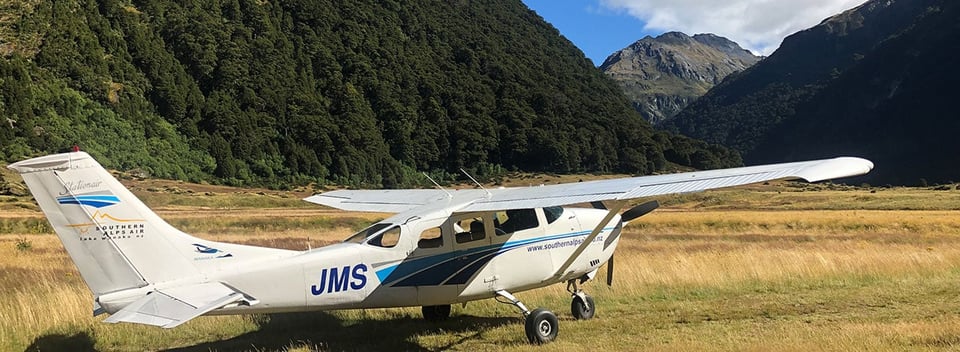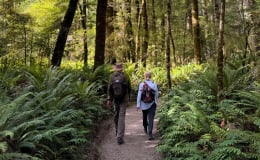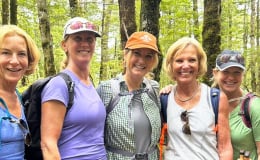
Scenic Flight into the NZ Wilderness
Into the wild. Flying in, hiking and jet boating through Mount Aspiring National Park, part of a UNESCO World Heritage area, for a breathtaking taste of the New Zealand backcountry.
A solitary kea soars high above, its cry echoes across the valley and breaks my concentration. I have been momentarily overcome by the grandeur and wildness that surrounds me as I stand on the grassy floor of the Siberia Valley. Towering mountains of dense beech forest loom either side, and an eery mist fills the air. Less than half an hour ago I was in civilisation. Now, I am well and truly in the wild, ready for the adventures ahead.
Elaine Maxwell echoes in my head, “I am the force. I can clear any obstacle before me or I can be lost in the maze. My choice. My responsibility. Win or lose; only I hold the key to my destiny.”
It feels like we should have hiked for days to get here. But that’s the beauty of doing the Siberia Experience - you don’t have to. Our trip began earlier this morning with an incredibly scenic (and much welcomed) flight that allowed us to dodge days of sweaty hiking.

Board a bush plane and head into the New Zealand backcountry.
We met our pilot, Will, standing by a light plane on the side of the road in Makarora. We climb aboard, and Will treats us to a stunning 25-minute scenic flight over the vast wilderness of the Southern Alps. We pass over glaciers, hanging valleys, braided rivers, sheer walls of schist, moraine slips, and snow-capped peaks. I am enthralled and intrigued by the fantastic-sounding landmarks Will points out, such as Wonderland Valley and Jumboland, although quietly relieved we will keep our distance from the dubiously named Mt Dreadful and Mt Awful.

A taster of the stunning views you will glimpse outside your window.
Over the course of the day, my fellow hiking companions and I will fly, hike and jet boat through breathtaking New Zealand backcountry in Mt Aspiring National Park. Today, ‘my destiny’ is a hike from the Siberia Valley Hut to the Wilkin Valley. I’ll admit that I have no idea what to expect. But the chance to fly, hike and jet boat all in one day was hard to refuse, kind of like a trifecta win.
“Welcome to Siberia”
"Welcome to Siberia," Will announces as we land. We have just touched down on what Will calls an airstrip and what I would call grass. He has deposited us in the stunning and remote Siberia Valley, a glacier-carved hanging valley within Mt Aspiring National Park, west of Makarora. A tiny dot on the map, Makarora is the stepping-off point for the West Coast of the South Island. From here on in, New Zealand’s wild Southern Alps take over the landscape and civilisation slowly gives way to wild majesty.
As I jump out of the six-seater plane, the chilly morning air hits me, and I immediately wonder if I've packed enough socks. Any concerns I have regarding cold feet are confirmed when our relentlessly positive guide, Lauren, informs us that the first order of business will be a river crossing through the cold, fast-flowing water of Siberia Stream.

Experience the remote wilderness of the elusive Siberia Valley.
As we walk toward the river, we pass a small group of hikers on their way out of the valley, due to catch Will’s flight back out. Despite the fact that it’s cold, their day began very early, and they have just waded through a glacier-fed river, they are beaming. Things are looking good.
“Think of Fiji,” Lauren offers brightly as I hesitate briefly on the banks of the Siberia Stream. Lauren’s pre-crossing briefing tips and her steadying nature soon have us safely to the other side, bouncing with newfound confidence.

Hiking in the Siberia Valley is serenity at its finest.
Siberia Valley lies within Mount Aspiring National Park, a vast swathe of dense bushland protected in the South Island’s Westland region. Mount Aspiring National Park is New Zealand’s third largest national park and is renowned for its diverse landscape of glaciated schist terrain and lush, dense forests of ancient beech and podocarps. It is part of the greater Te Wāhipounamu (the ‘greenstone waters’), a UNESCO World Heritage area composed of some two million hectares of critically important landscape. The flora, fauna and rock deposits of Te Wāhipounamu represent a direct link back to a landscape that existed 80 million years ago when New Zealand was part of Gondwana.
River crossing accomplished, we head to Siberia Hut where Lauren gives a pre-hike briefing to run us through the schedule for the day. I take a peek inside the hut and am impressed by its large bunk rooms, modern kitchen, wood burner and huge, well-positioned windows that afford stunning views up the valley. It’s very well maintained by the Department of Conservation (DOC), who manage a network of over 950 backcountry huts and shelters dotted around New Zealand, although not all of them up to this high standard.
Standing beside the hut, I take in the sight before me. Dense forest covers the mountains down to the valley floor and waterfalls sporadically break forth from the sheer rock walls. The river rushes alongside us, and birdsong fills the air. The sights and sounds of Mother Nature take over, and I can feel my day-to-day worries slowly slipping away into insignificance.
“Already I feel a long way from civilisation, and I couldn’t be happier about it.”
Already I feel a long way from civilisation, and I couldn’t be happier about it. I could sit and meditate on the wild beauty of this landscape forever. The spell is momentarily broken as I watch another group of hikers solemnly prepare to set off for the day. They tell us they are walking to Crucible Lake. I have heard tales of this curious lake, which is a challenging 6-hour return hike from the hut and by all accounts worthy of solemn preparation. Lauren assures us our hike will be less demanding, but just as rewarding. Tummies full from the nourishing picnic lunch Lauren conjures up for us, we are ready to begin the trek.
Today, we’ll do a hike from Siberia Valley to the Wilkin Valley, where we’ll meet the jet boat for the final leg of our journey back to Makarora. Setting off at a relaxed pace, we briefly follow Siberia Stream along the valley floor. The day has warmed up, and the track is easy underfoot. We cross a few small streams trickling down from the mountains high above. A well-formed track takes us through the beech forest and over to the neighbouring valley. Beech forest is not an impenetrable forest; only small undergrowth survives beneath the canopy, leaving a clear view through the trees. Dappled sunlight sneaks through, highlighting myriad shades of green. Walking amongst the majesty of these old giants is my favourite therapy.

Experience the thrill of backcountry jet boating in New Zealand.
The walk gives us a chance to chat with Lauren. She points out native shrubs, ancient trees and talks about the history of the area, which has seen both cattle grazing and deer recovery play a significant role in shaping the landscape. Ever the vigilant guide, Lauren adjusts a fellow hiker’s pack to ease his aching shoulders. As we walk, I wince at the size of Lauren’s gargantuan backpack, which she carries like it was nothing more than a daypack. I realise she must have to carry much more than an extra water bottle to keep her clients happy and safe and I am once again grateful to have her by my side.
Soon, we’re descending into Kerin Forks Flat before arriving in the Wilkin Valley. Lush green grass carpets the valley floor, and it’s easy to see why the area was used for grazing before it became a national park. The Wilkin River is blue, beautiful but too big to cross on foot. Cue jet boats.
I am excited about the prospect of the jet boat, but a little saddened that it will whiz us back to civilisation. I haven’t missed real life and a day away has had the same effect as two weeks away. There’s a lot to be said for the impact that remote wilderness, a bit of dirt and an honest sweat has on the soul.
Arriving at the edge of the river, I’m reminded why it’s worth leaving our comfort zone now and then. Staring at the view in front of me, it has all been worth it.
We sit in the grass at the jet boat pick up point and I try to bank a little of this good feeling. The grass is long, the sun is warm and I welcome the chance to rest my legs. Even the sandflies are courteous and show little enthusiasm for attacks today.
If there’s one thing I love more than hiking in the mountains, it’s little comforts along the way and all the better when they appear as if by magic. The indomitable Lauren delivers, of course, and today we enjoy afternoon tea on the banks of the river. Lauren pulls out a gas stove, a coffee plunger, tea, and choc-chip biscuits from her mighty backpack. I eye up her backpack and do a quick calculation on how many packets of biscuits she may potentially be carrying. When I return to Makarora later, I will be a little weary, a little in need of more chocolate biscuits, but utterly exhilarated by the experience.

Whizzing through Siberia Valley.
Eventually, a distant hum reveals itself to be the roar of a jet boat. We hustle to the river’s edge to secure our spot before a second jet boat arrives to carry our gear. This arrangement appears to be for the purpose of leaving our boat light enough to engage in some serious thrills on the way back down the river. The 50 km jet boat journey takes around 30 minutes and includes complimentary 360-degree spins and plenty of big smiles. We arrive back in Makarora happy, slightly wet and grateful that we didn’t have to carry more than our day bags or walk the entire way out.
I’ve done my fair share of hiking in the New Zealand wilderness. This is not the first time I have hiked hanging valleys, seen snow-capped peaks or jet boated braided rivers. But I will never tire of this, never be unimpressed by this. The day that I am no longer utterly enthralled and in awe of the pristine landscapes of the New Zealand backcountry is the day I hang up my boots and give up chocolate biscuits. It will never happen.
– Written by Stephanie Johnstone
Do the Siberia Experience on our Pure South trip.
You can watch a short taster video of the Siberia Experience in this video.







